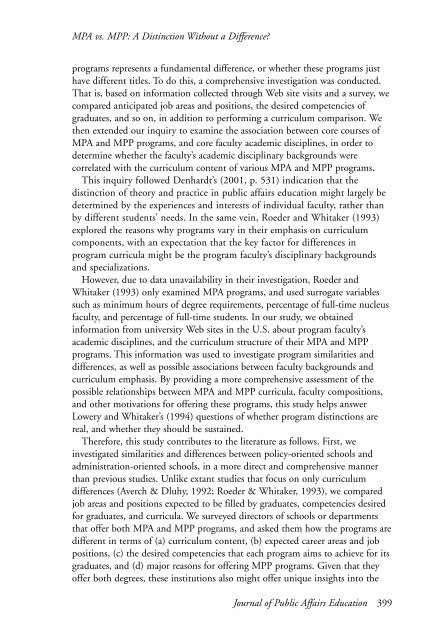JOURNAL OF PUBLIC AFFAIRS EDUCATION - National ...
JOURNAL OF PUBLIC AFFAIRS EDUCATION - National ...
JOURNAL OF PUBLIC AFFAIRS EDUCATION - National ...
You also want an ePaper? Increase the reach of your titles
YUMPU automatically turns print PDFs into web optimized ePapers that Google loves.
MPA vs. MPP: A Distinction Without a Difference?<br />
programs represents a fundamental difference, or whether these programs just<br />
have different titles. To do this, a comprehensive investigation was conducted.<br />
That is, based on information collected through Web site visits and a survey, we<br />
compared anticipated job areas and positions, the desired competencies of<br />
graduates, and so on, in addition to performing a curriculum comparison. We<br />
then extended our inquiry to examine the association between core courses of<br />
MPA and MPP programs, and core faculty academic disciplines, in order to<br />
determine whether the faculty’s academic disciplinary backgrounds were<br />
correlated with the curriculum content of various MPA and MPP programs.<br />
This inquiry followed Denhardt’s (2001, p. 531) indication that the<br />
distinction of theory and practice in public affairs education might largely be<br />
determined by the experiences and interests of individual faculty, rather than<br />
by different students’ needs. In the same vein, Roeder and Whitaker (1993)<br />
explored the reasons why programs vary in their emphasis on curriculum<br />
components, with an expectation that the key factor for differences in<br />
program curricula might be the program faculty’s disciplinary backgrounds<br />
and specializations.<br />
However, due to data unavailability in their investigation, Roeder and<br />
Whitaker (1993) only examined MPA programs, and used surrogate variables<br />
such as minimum hours of degree requirements, percentage of full-time nucleus<br />
faculty, and percentage of full-time students. In our study, we obtained<br />
information from university Web sites in the U.S. about program faculty’s<br />
academic disciplines, and the curriculum structure of their MPA and MPP<br />
programs. This information was used to investigate program similarities and<br />
differences, as well as possible associations between faculty backgrounds and<br />
curriculum emphasis. By providing a more comprehensive assessment of the<br />
possible relationships between MPA and MPP curricula, faculty compositions,<br />
and other motivations for offering these programs, this study helps answer<br />
Lowery and Whitaker’s (1994) questions of whether program distinctions are<br />
real, and whether they should be sustained.<br />
Therefore, this study contributes to the literature as follows. First, we<br />
investigated similarities and differences between policy-oriented schools and<br />
administration-oriented schools, in a more direct and comprehensive manner<br />
than previous studies. Unlike extant studies that focus on only curriculum<br />
differences (Averch & Dluhy, 1992; Roeder & Whitaker, 1993), we compared<br />
job areas and positions expected to be filled by graduates, competencies desired<br />
for graduates, and curricula. We surveyed directors of schools or departments<br />
that offer both MPA and MPP programs, and asked them how the programs are<br />
different in terms of (a) curriculum content, (b) expected career areas and job<br />
positions, (c) the desired competencies that each program aims to achieve for its<br />
graduates, and (d) major reasons for offering MPP programs. Given that they<br />
offer both degrees, these institutions also might offer unique insights into the<br />
Journal of Public Affairs Education 399

















